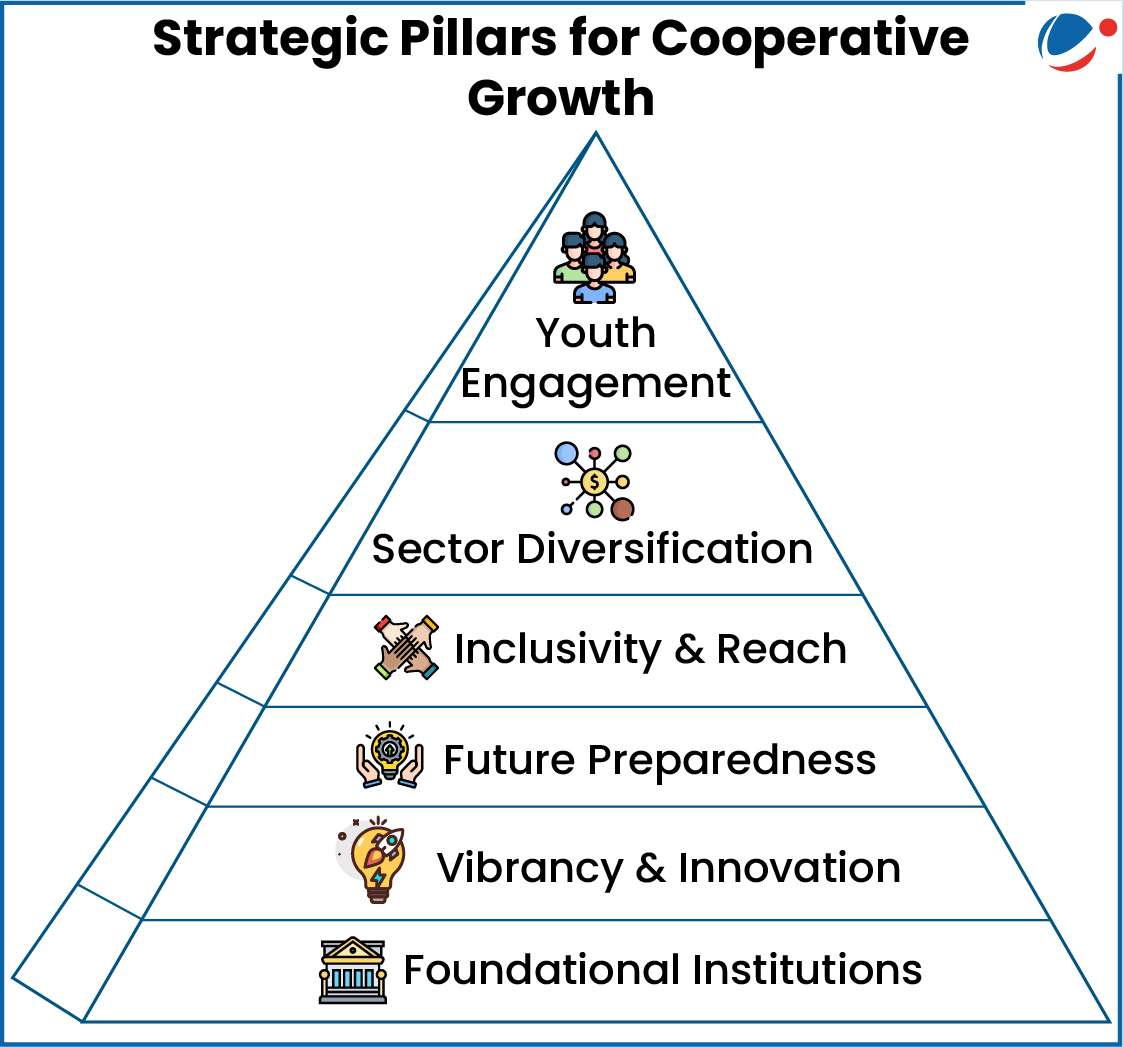Why in the news?
Recently, the Union Minister of Cooperatives unveiled the National Cooperative Policy 2025.
Key features of the policy
- This is only the second such policy for the cooperative sector, after the first in 2002.
- Vision: To make cooperatives key drivers for Viksit Bharat 2047 through Sahkar-se-Samriddhi.
- Objectives: To bring 50 crore citizens, who are either not members or are inactive in the cooperative sector, into active participation.
- Policy envisions six strategic mission pillars (Infographic).
- Other key features of policy include

- Legislative and Institutional Reforms: Encourage States to amend cooperative laws to enhance transparency, autonomy and the ease of doing business.
- Financial Empowerment: Bring down cooperative taxes and make cooperatives eligible for sector-specific finance incentives available to corporates.
- Business Ecosystem Development: Encourage States/UTs to develop at least one model cooperative village, Support branding under the 'Bharat' brand, etc.
- Future-Readiness & Technology: Develop a national 'Cooperative Stack' integrating with Agri-stack and databases.
- New Sectors: Consider expanding cooperatives into new sectors, including clean energy, waste management, and technology.
- Inclusivity: Promotes inclusive participation of women, youth, SC/STs.
- Other: Tripling the cooperative sector's GDP contribution by 2034, increasing the number of cooperative societies by 30%, etc.
- Implementation: By the 'Implementation Cell' under the Ministry of Cooperation.
- Monitoring: By the 'National Steering Committee on Cooperation Policy', chaired by the Union Minister of Cooperation.
Cooperatives in India
- Origin: With the Cooperative Credit Societies Act, 1904.
- Definition: It is an autonomous association of persons, united voluntarily to meet their common economic, social, and cultural needs and aspirations through a jointly owned and democratically member-controlled enterprise.
- Status
- India has more than 8 lakh cooperative societies ( 2 lakh credit cooperatives (E.g., PACS) and 6 lakh non-credit cooperatives (E.g., Consumer, Housing Cooperatives)).
- More than 30 crore people are associated with co-operatives in India.
- Top 3 Cooperative sectors: Housing, Dairy, and Primary Agricultural Credit Society (PACS).
- Constitutional Status: The 97th Amendment, 2011, granted constitutional status to the Cooperative Societies with the following provisions-
- Fundamental Right: Added "cooperative societies" in Article 19(1)(c).
- Directive Principle: Inserted Article 43B to promote cooperatives.
- New Part IXB: Added Articles 243ZH to 243ZT for cooperative governance.
- Governance Structure
- Multi-State Cooperatives: Falls under the Union List of the Constitution. Governed by the Multi-State Cooperative Societies Act, 2002.
- State Cooperatives: Falls under the State List of the Constitution. Governed by respective State Cooperative Societies Acts.
Significance of cooperatives
- Uplifting the rural economies: By fostering financial inclusion e.g., About 1/3rd of India's rural population is directly connected to cooperatives.
- Boost to farmers' income: By allowing pooling of resources, enhanced bargaining power, e.g., Amul model of Gujarat.
- Societal Impact
- Empowering Women: E.g., Sewa Cooperative Bank enable microfinance leading to women's employment and gender equality.
- Sustainable growth: E.g., Uralungal Labour Contract Cooperative Society's (ULCCS) of Kerala, implementation of green practices in the development of infrastructure development
- Strengthened community ties: Cooperatives foster a sense of community, which leads to building social capital.
- Instilling Values –
- Equality: The "one-person-one-vote" system ensures equality.
- Leadership: Cooperatives elect leaders democratically, helping develop leadership skills (e.g., in Maharashtra many legislators are associated with the cooperative movement).
Challenges for Cooperatives
- Limited capacity and resources: Especially in emerging or rural economies, cooperatives may lack the necessary infrastructure, training, and technical expertise to function effectively
- Political Intervention: Interference by political parties and leaders often affects transparency and leads to inefficiency.
- Complex Regulatory requirements: leading to bureaucratic hurdles and slow development of cooperatives in India.
- Lack of Familiarity with Digital Tools: The data indicates that only 45% of cooperative members are familiar with digital tools.
- Regional imbalance: The top 5 states (Maharashtra, Gujarat, Telangana, Madhya Pradesh, and Karnataka) have 57% of all cooperatives.
- Other challenges - Skilled Workforce Shortage, lack of cooperation among the cooperative Limited membership and resources etc
Conclusion
Cooperatives can be strengthened by encouraging private sector partnerships to boost infrastructure and provide access to advanced technology. Additionally, promoting inclusivity, merging weak societies, and ensuring transparency through measures like the Cooperative Governance Index (CGI) and the Right to Information (RTI) Act.



